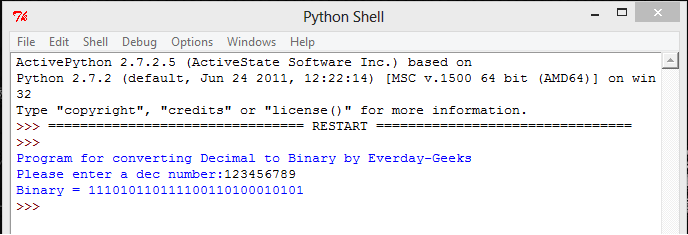


This will render our original integer number. We can convert back this to integer: int.from_bytes(b'P"\x99\xd8', "big") This will return the following bytes object: b'P"\x99\xd8' Next we’ll convert our hex string: binascii.unhexlify(my_hex) This will return the following string: 0x502299d8 Then use the unhexlfy() method to revert your hex string to bytes. First off make sure to import the library (otherwise you will receive a ModuleNotFound exception). We can convert hexadecimals to bytes using the binascii library. We can cast the binary to int to verify our conversion. This will return the following binary: '0b1000000000' Then, conversion to binary will work: bin (int(my_hex, base=16)) We need to make sure to specify that my_hex is a hexadecimal, that is a number of base=16. The solution is to simply tweak the conversion to integer a bit. Running a simple conversion using the bin() function renders a TypeError exception: bin (my_hex) T ypeError: 'str' object cannot be interpreted as an integerĬonverting the hexadecimal to integer, and then converting to binary also renders an error: bin (int(my_hex)) ValueError: invalid literal for int() with base 10: '0x200' Change hexadecimal to binary Let’s assume that we have the following hexadecimal (which represent the integer value 512) my_hex = '0x200' The resulting string will start with the prefix ‘0b’ and if further operations are needed on the binary number, it is necessary to remove this prefix and use `int(binary_string, 2)` for conversion back into an integer.We would like to convert an hexadecimal number to a binary number system (or from base 16 to base 2). The int () function takes as second argument the base of the number to be converted, which is 2 in the case of binary numbers.

And similarly, the int () function to convert a binary to its decimal value. The `bin()` function in Python can be used to convert an integer into its binary representation as a string. In Python, you can simply use the bin () function to convert from a decimal value to its corresponding binary value. Remember that the result will be a string, so if you want to perform further operations on the binary number, you may need to remove the ‘0b’ prefix and convert the remaining binary string to an integer using `int(binary_string, 2)`. Print(binary_representation) # Output: '0b1010' The resulting string starts with the prefix ‘0b’ to indicate it’s a binary number. The `bin()` function in Python is used to convert an integer to its binary representation in the form of a string. Let’s look at how it works: Programming Guide It takes an integer as input and returns the corresponding binary number as a string, starting with ‘0b’ prefix. Are you looking for a way to convert an integer into its binary representation? The `bin()` function in Python can help with that.


 0 kommentar(er)
0 kommentar(er)
